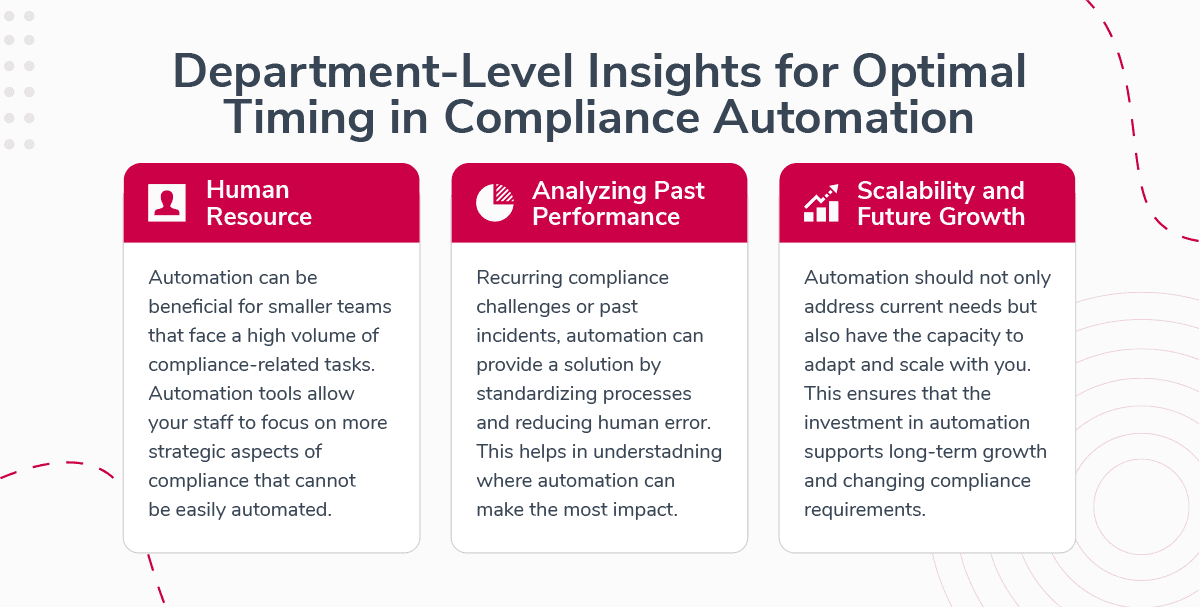Published on: Feb 6, 2024
Identifying the Optimal Timing for Compliance Automation: A Strategic Guide
This article guides you through identifying the optimal timing for compliance automation, focusing on organizational readiness and strategic alignment for a successful implementation.
A short recap.
In the first article of this series, we explored the reasons why you should automate compliance, including a comprehensive review of efficiency gain and real-time monitoring benefits.
Now it is time to discuss the optimal timing for compliance automation—the when.
Let's dive in.
Understanding the Optimal Timing for Compliance Automation
Understanding when to move forward with compliance automation is a strategic decision. Not all organizations or compliance departments are ready at the same time. Recognizing the optimal timing for compliance automation is key to ensuring a successful digital transformation in this area.
To determine the right time to move forward in automating compliance, including the evidence-gathering piece, you should consider several critical factors at the organizational level.
Here they are:
Maturity of the Compliance Department
The level of maturity within your compliance department significantly affects the optimal timing for introducing automation. Automation thrives in an environment where compliance processes are already standardized and well-understood.
Having this maturity level will make it easier to automate repetitive tasks and processes.
By the way, if you want to learn more about compliance documents hierarchy, check this out.
Complexity of Compliance Program
The complexity of your compliance program can also dictate the optimal timing for automation. You should consider the complexity of the compliance program, including the number of regulations, standards, and guidelines the organization must adhere to.
A compliance management system usually can help with this.
Remember the following:
A higher complexity may indicate a need for automation to efficiently manage and track compliance across multiple requirements.
Number of Audits
The number of audits your organization undergoes, and their frequency, can be a clear indicator of the need for automation. A higher number of audits implies a greater need for streamlined, efficient processes.
Automation can significantly enhance audit readiness, ensuring that compliance evidence is organized, up-to-date, and readily available.
Technological Readiness and Infrastructure
Your organization's technological preparation is crucial in determining the optimal timing for automating compliance processes. Ensure that the necessary tools and systems are in place to support automated compliance processes.
Now, this decision should be made with a holistic view of your organization's needs, considering both current capabilities and future aspirations. It's not just about solving immediate challenges; it's about setting the stage for long-term compliance and operational success.
Therefore, understanding the right time to automate compliance becomes a strategic decision that encompasses various aspects of your organization's operations, culture, and future growth plans.
There are also specific considerations that must be done at the department level.

Department-Level Insights for Optimal Timing in Compliance Automation
While organizational factors set the broader context for automation, specific departmental aspects also play a crucial role in deciding the right time to automate compliance processes. At the departmental level, the following considerations are crucial for determining the optimal timing for compliance automation:
Human Resources
Evaluate the size and capabilities of your compliance team. Automation can be particularly beneficial for smaller teams that face a high volume of compliance-related tasks. It's not just about reducing the workload; it's about enhancing the efficiency and effectiveness of the team.
Automation tools can free up valuable time for your staff, allowing them to focus on more strategic aspects of compliance that cannot be automated.
Analyzing Past Compliance Performance
A thorough review of your organization's history with compliance issues is informative. If there are recurring compliance challenges or past incidents, automation can provide a solution by standardizing processes and reducing the likelihood of human error.
This perspective helps in understanding the areas where automation can make the most significant impact in mitigating risks.
Scalability and Future Growth
Factor in how your organization is expected to grow and evolve. The scalability of your compliance efforts is vital. Automation solutions should address current needs and adapt and scale with your organization.
This foresight ensures that the investment in automation supports long-term growth and changing compliance requirements.
By carefully considering these points, organizations can make informed decisions regarding the right time to move forward with automating compliance, ensuring a smoother transition and enhanced effectiveness in compliance management.

Recognizing the Signs: When is The Optimal Timing for Starting Compliance Automation?
Another indicator that might be time to kick off an automation project is when improved visibility becomes a necessity.
Improving visibility in compliance is a fundamental objective in the domain of compliance automation and automated evidence gathering. This involves enhancing the ability to closely monitor and understand various aspects of compliance processes and activities within an organization.
By integrating advanced technological solutions, businesses can elevate their capacity to track compliance-related data, transactions, and operations, thereby significantly enhancing their visibility into the compliance landscape.
One of the key advantages of improved visibility in compliance, facilitated by compliance automation and automated evidence gathering, is the ability to generate comprehensive and accurate reports.
What about the reports?
These reports are not only timely but also highly detailed, providing a holistic view of an organization's adherence to regulatory requirements and internal policies. Enhanced reporting capabilities empower stakeholders to make informed decisions and optimize their compliance strategies based on precise and up-to-date information.
This not only saves time and resources but also enhances the accuracy and reliability of compliance evidence, strengthening an organization's confidence in its compliance posture.
The synergy of compliance automation and automated evidence gathering plays a pivotal role in achieving increased visibility within the compliance domain.
This increased visibility leads to improved reporting capabilities, enabling more informed decision-making, and streamlined evidence-gathering processes, strengthening an organization's overall compliance efforts.
The Future of Compliance: Embracing Optimal Timing for Automation
As we conclude this series, it's clear that understanding the optimal timing for compliance automation is crucial for any organization looking to evolve its compliance strategies effectively.
In this comprehensive series on Compliance Automation, you have learned about the evolving landscape of Governance, Risk, and Compliance (GRC), emphasizing that compliance is no longer a choice but a mandatory endeavour.
Compliance Automation has transformed the roles of information security and compliance professionals, catalyzing digital transformation within their departments.
Here is a quick reflection on this series about automation.
Final Thoughts: From 'Why' to 'What', and Now 'When'
In the first article, we examined the 'why' of Compliance Automation. We highlighted its efficiency gains and its role in streamlining workflows, thereby saving time and reducing costs.
This article has focused on understanding 'when' the right time is to implement automation, aligning this decision with factors like the maturity of the compliance department, the complexity of compliance programs, audit frequency, and technological readiness.
Understanding when the right time is to implement automation is crucial, which forms the focus of our third article. We have emphasized that the timing should align with factors such as the maturity of the compliance department, complexity of compliance programs, audit frequency, and technological readiness.
Moreover, as automation becomes a need, improving visibility within compliance processes is vital.
Compliance automation and automated evidence gathering facilitate enhanced reporting capabilities, providing accurate, timely, and detailed insights. This heightened visibility allows stakeholders to make informed decisions, significantly benefiting an organization's compliance posture.
Now, it is time for you to act.
Evaluate your organization's readiness for compliance automation. Assess where you stand in terms of compliance maturity, complexity, and audit frequency. Recognize the importance of visibility and the advantages it brings.
Connect with us to help you build a path to compliance excellence. Remember that everything lies in strategic decision-making and embracing the power of automation.







